Embarking on a new embroidery project, I often find myself surrounded by colorful embroidery floss skeins. Each offers creative possibilities, from delicate floral patterns to intricate geometric designs.
Yet, understanding the best way to use these skeins can be challenging for beginners and seasoned embroiderers.
When starting your first embroidery project, it’s natural to wonder about the basics – including how many embroidery floss to use.
Should you separate the threads or leave them as is? The answer depends on your desired effect and the type of stitch you plan on using.
Peering closely at a skein of thread, you’ll notice it’s composed of six individual strands twisted together. This design isn’t just for aesthetics: it allows embroiderers flexibility.
If you want bold lines and filled areas, you might opt for all six strands, but if delicate details are your style, one or two strands should suffice.
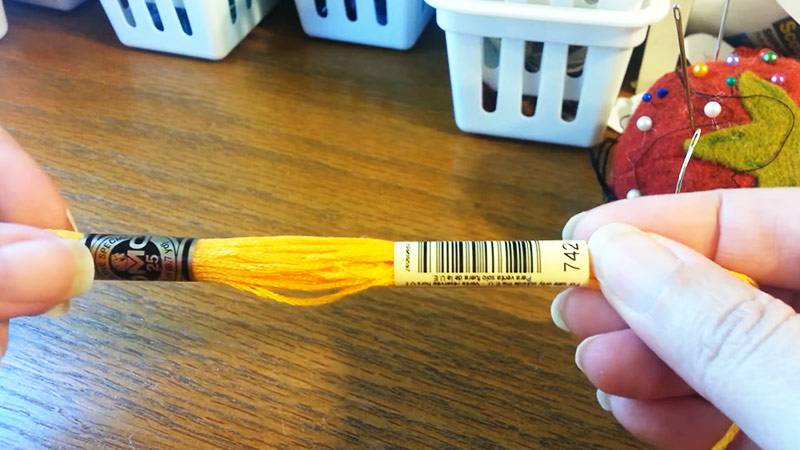
What is Embroidery Floss?
Embroidery floss, an essential companion for every embroidery enthusiast, is a loosely twisted, slightly glossy thread commonly used for stitching. It’s typically made from cotton, silk, rayon, or linen. The floss comes wound in small bundles known as skeins.
Each skein of embroidery floss usually contains six individual strands or threads. The beauty of these separate threads lies within their versatility – you can choose how many strands to use depending on the detail and texture you want to achieve in your project.
For instance, using a single strand will give you fine lines for detailed work, while using all six strands will provide a bold line for making a statement!
The color variety available in embroidery floss skeins is simply breathtaking! From vibrant reds and blues to subtle pastel shades – there’s something to cater to every creative whim.
The length of each skein varies by brand, but on average, you’ll find that most skeins contain about 8 meters (or roughly 26 feet) of thread. This abundance ensures you have plenty of material for your projects.
It’s important not to get too carried away when pulling apart the strands. They tend to knot and tangle if not handled with care! To avoid this hassle, it’s recommended to cut your embroidery floss into manageable lengths before separating the strands.
To wrap up this section on what embroidery floss is – it’s much more than just a skein of thread! It’s a versatile tool that allows artists like yourself flexibility in texture and design options when creating beautiful embroidered pieces.
Types of Embroidery Floss
Embroidery floss comes in various types, each with unique characteristics and uses. Understanding the different types of embroidery floss can help you select the right one for your specific project.
Here’s a closer look at some common types:
Six-Strand Floss
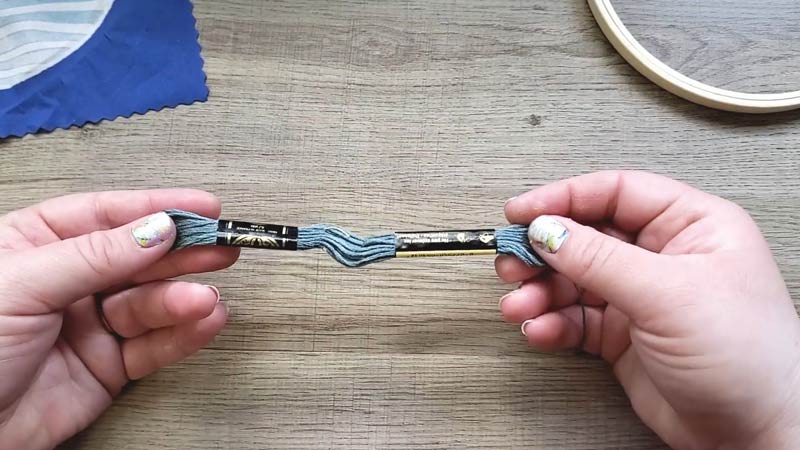
This is the most ubiquitous type of embroidery floss found in craft stores. It consists of six individual strands twisted together. One of the critical advantages of six-strand floss is its versatility.
You can separate the strands to adjust the thickness of your stitches, making it suitable for a wide range of embroidery techniques and designs.
Floche
Floche is a premium embroidery floss made from five fine threads twisted into a single strand. It has a silky smooth texture and luxurious appearance, making it ideal for delicate, intricate designs.
While cloche tends to be more expensive than other types of embroidery floss, its high-quality finish makes it a favorite among experienced embroiderers.
Pearl Cotton
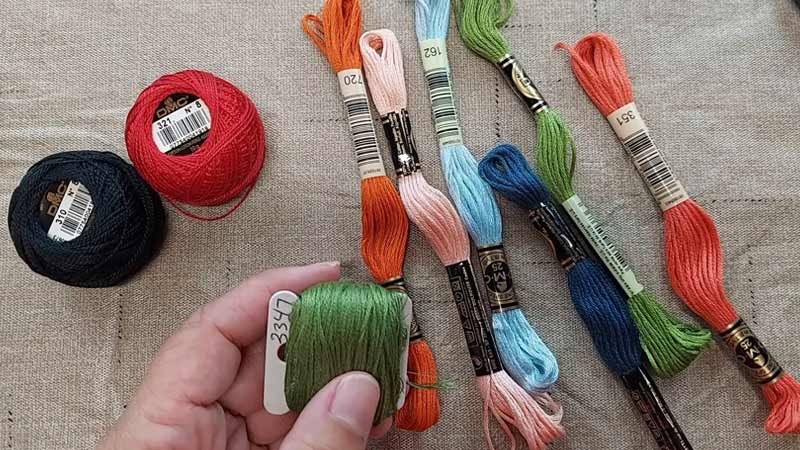
Unlike six-strand floss, pearl cotton cannot be separated into smaller strands. It has a smooth, lustrous surface that gives off a distinctive sheen, adding dimension to your embroidery work.
Pearl cotton is often used for bold, decorative stitches and surface embroidery where a thicker thread is desired.
Rayon Floss
Rayon floss is similar in structure to six-strand floss but is made from rayon fibers, giving it a superior shine and silkiness. It is often used for embellishments and decorative stitching where a glossy finish is desired.
Rayon floss adds a touch of elegance to embroidery projects and is available in a wide range of vibrant colors.
Metallic Threads
Metallic threads are made from synthetic materials known for their sparkly appearance. They add glamour and visual interest to embroidery projects, especially those intended for special occasions or festive decorations.
However, metallic threads can be tricky to work with as they tend to unravel and wrinkle, requiring careful handling and stitching techniques.
Choosing the Right Skein of Embroidery Floss
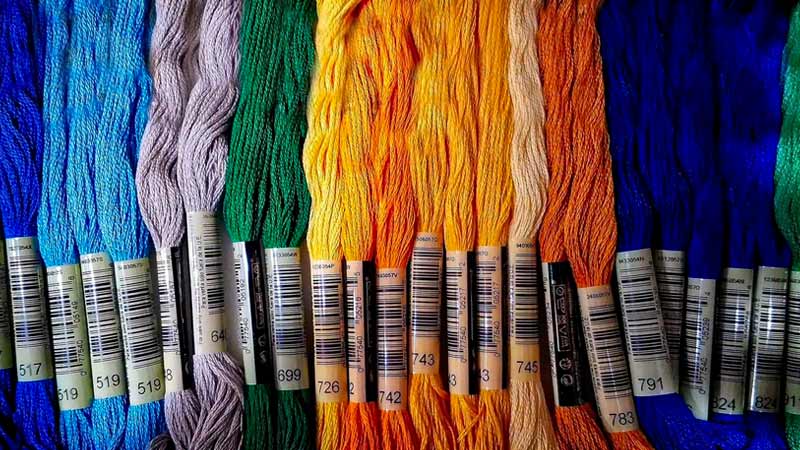
Selecting the perfect skein of embroidery floss is a crucial step in ensuring the success of your embroidery project. Here are some essential considerations to keep in mind:
Color
The color of your embroidery floss can significantly impact the overall look of your design. Choose colors that complement your pattern, whether for bold hues or subtle shades.
It’s advisable to purchase an extra skein to account for any potential variations in dye lots and avoid color mismatches.
Strand Count
The number of strands you use can affect the density and appearance of your stitches. While two strands are commonly used for standard cross-stitch on 14-count fabric, you can adjust the strand count to achieve different effects.
Experiment using three or four strands for a denser look, but ensure your fabric can accommodate the thickness.
Quality
Opting for high-quality embroidery floss is essential for a smooth stitching experience. Lower-quality threads are more prone to knots, tangles, snags, and breaks, disrupting your progress and leading to frustration.
Investing in quality threads ensures better results and a more enjoyable stitching process.
Specialty Threads
Consider incorporating specialty threads such as variegated or metallic floss into your design for added visual interest. Variegated threads feature subtle color changes within the strand, creating unique and dynamic effects.
Metallic threads add sparkle and glamour to your embroidery but require extra care during stitching due to their tendency to unravel and tangle.
Organizing Your Skeins of Embroidery Floss
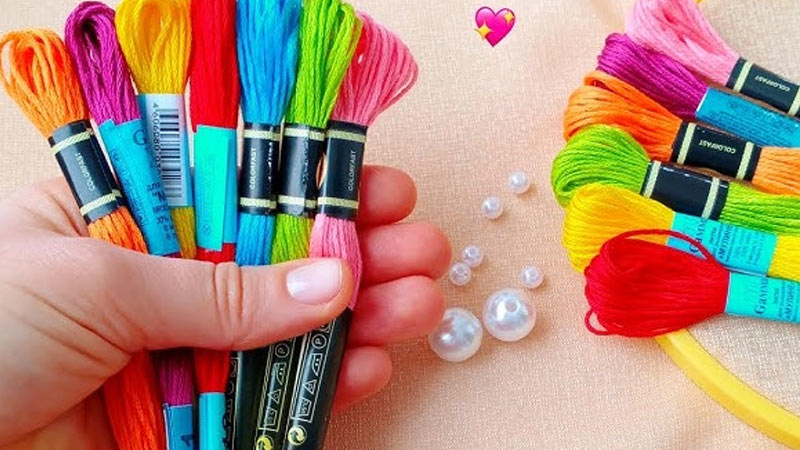
Organizing your skeins of embroidery floss is essential for maintaining a tidy workspace and ensuring smooth stitching sessions.
Here are some practical methods for keeping your floss in order:
Keep Skeins Intact
Resist the temptation to unwind an entire skein at once. Keeping each skein intact until you’re ready to use it helps prevent knots and tangles from forming. Exercise patience and unwind only the length of thread you need for your current project.
Plastic Floss Bobbins
Plastic floss bobbins are a popular and cost-effective solution for organizing embroidery floss. Wind each strand of floss around a bobbin and label it with the corresponding color number for easy identification. These bobbins are lightweight and readily available at most craft stores.
Floss Organizer Boxes
Invest in a floss organizer box if you have an extensive embroidery floss collection. These boxes typically feature individual compartments for each bobbin, keeping them neatly organized and easily accessible.
The transparent design of these boxes allows you to see all your colors at a glance, making it simple to find the shade you need.
Strand Count
Consider the desired thickness of your stitches when determining how many strands of embroidery floss to use. Six strands are typically used for thick lines or fill-in a design.
Four strands work well for medium thickness, while delicate lines may require only one or two strands. Adjust the strand count according to your project’s requirements to achieve the desired effect.
Creative Uses for Skeins of Embroidery Floss
Embroidery floss isn’t just for stitching; it’s a versatile material used in various creative projects.
Here are some exciting ways to explore the potential of embroidery floss beyond traditional needlework:
Jewelry Making
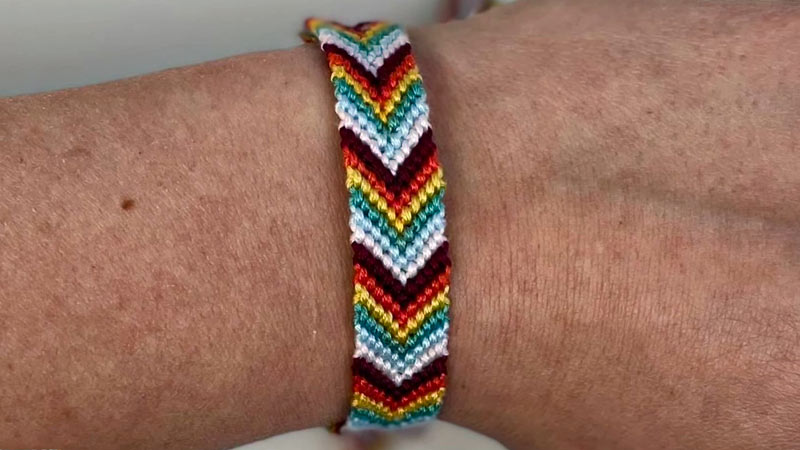
Use embroidery floss to craft unique and personalized jewelry pieces such as bracelets, necklaces, and earrings. Experiment with different braiding and knotting techniques to create intricate patterns and designs.
Mix and match colors and textures to suit your style and create eye-catching accessories.
Decorative Crafts
Transform embroidery floss into decorative elements for your home. Create colorful tassels to adorn curtains, cushions, or lampshades. Make vibrant wall hangings by weaving or macramé techniques.
Wrap embroidery floss around wooden letters or shapes to spell out words or create personalized wall art.
DIY Projects
Explore a variety of DIY projects using embroidery floss. Make bookmarks by braiding or knotting strands together and adding decorative charms or beads. Create unique keychains by braiding floss around a keyring and adding embellishments.
Craft dream catchers using embroidery hoops, feathers, and colorful threads for a whimsical touch.
Varied Strand Usage
When determining how many strands of embroidery floss to use, consider the specific requirements of your project. Fewer strands may be more suitable for delicate jewelry or fine detail work.
Experiment with different strand counts to achieve your creations’ desired thickness and texture.
Conclusion
I’ve navigated through the vibrant world of embroidery floss, discovering a kaleidoscope of colors each thread skein offers.
It’s like holding a rainbow in my hand. The delicate yet resilient strands have shared their tales with me, and I’m here to share those insights with you.
Embroidery floss skeins are an essential part of any embroiderer’s kit. With them, we can create designs that reflect our spirit and personality. But one question often baffles beginners – how many strands of embroidery floss to use?
While it might seem daunting at first glance, the answer is simple – it depends on your project. Using two strands might be ideal if you’re working on something intricate requiring detailed work. Six strands serve better to fill larger areas or create bold lines.
Let’s summarize:
- Detailed work: 2 strands
- Bold lines/large fillings: 6 strands
Now you’re equipped with the basics about embroidery floss skeins! Remember these tips and embrace the creative journey ahead.
In my experience as an embroiderer, I’ve learned that every skein of thread has its own story to tell – from its origin to being woven into a piece of art by skilled hands. It’s not just a tool; it becomes part of our creative expression and narrative.
So next time you hold a skein of embroidery thread in your hands, remember this – behind every beautiful piece lies hours spent intricately weaving threads together, stitches made with patience and care, mistakes turned into lessons, moments spent in quiet contemplation and bursts of inspiration!
It’s not just thread – it’s the start line for creativity! So go ahead, pick up your needle, and make magic happen!
Leave a Reply